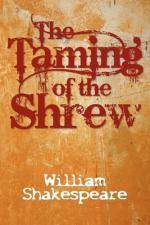|
This section contains 9,770 words (approx. 33 pages at 300 words per page) |

|
SOURCE: Hodgdon, Barbara. “Katherina Bound; or, Play(K)ating the Strictures of Everyday Life.” PMLA 107, no. 3 (May 1992): 538-53.
In the following essay, Hodgdon discusses notions of sexual differences and gender roles in The Taming of the Shrew.
When Kate delineates a wife's duties to “her loving lord” within a hierarchical configuration of marriage, Shakespeare's Taming of the Shrew ends in a “frenzy of the social” (cf. Comolli 121), putting on offer an image of “woman” that the play's male characters use as a means of speaking to one another about themselves. As one among many texts, nondramatic as well as dramatic, that participate in a conversation about the organization of sexual difference in early modern England,1 Shrew [The Taming of the Shrew] demonstrates precisely the “fine surge of historical intelligibility” that Roland Barthes attributes to Sade's writing (Sade/Fourier/Loyola 10). Today, the anxiety over gender roles and attributes that...
|
This section contains 9,770 words (approx. 33 pages at 300 words per page) |

|


